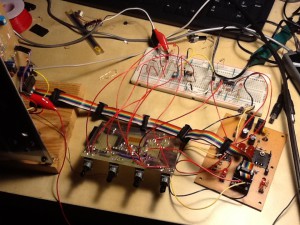Inter Module Communication
I’m going to try making a digital communication bus for synthesizer modules.
Analog synth has a very simple control language which is voltage. Any message is translated to voltage that can be read by any modules that accept voltage input. So for example, VCO output is basically audio output but also can be used as control voltage of some other modules, such as VCO cross modulation.
This simple data exchange methodology makes analog synthesizer very versatile and flexible. However, as a drawback, patch wiring would become too complicated as you make complex module network.
One solution for making the wiring simple is to use a single common data bass where all modules are connected, and exchange data selectively using some software. Apparently, making such a bass for analog signals is impossible or extremely difficult. So I’m going to try making it using a digital bass.





